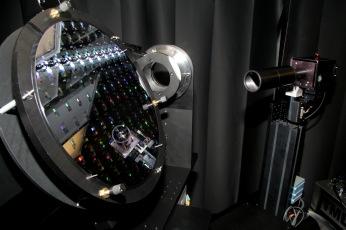Bidirectional optical scattering facility

Goniometric optical scatter instrument (GOSI)
The bidirectional reflectance distribution function (BRDF) quantifies the angular distribution of radiation scattered from a surface as a function of wavelength, polarization state, and angle of incidence. The bidirectional characterization of optical scatter from surfaces is a useful metrological tool in evaluating elements contained within optical systems that require the minimization of scattered light for high image contrast or radiant energy density control. It is also effective for the characterization of materials and surfaces in control and inspection processes in manufacturing settings. The Goniometric Optical Scatter Instrument (GOSI) at NIST employs ultraviolet, visible, and infrared laser light sources and highly sensitive detection schemes. This instrument is well-suited for studying low-scatter surfaces such as silicon wafers and optically smooth mirrors. Other applications include assessment of the uniformity of periodic structures such as gratings, patterned photoresists, or built-up patterns on semiconductor surfaces.
This facility is a part of the Sensor Science Division's Optical Properties of Materials focus program.
Specifications/Capabilities
- Measurements of diffuse scatter in reflection and transmission.
- Currently available wavelengths: 532 nm, 633 nm, 1064 nm, 4 µm, 5 µm, and 10.6 µm. Other wavelengths can be accommodated based upon need.
- In the visible and ultraviolet, GOSI has a dynamic range of about 15 orders of magnitude (in units of sr-1), and a noise level of 10-9 sr-1 determined by Rayleigh scattering in the air surrounding the sample.
- The scatter direction can be measured with angular resolutions of approximately 0.7°, 0.2°, 0.1°, and 0.02°.
- Polarimetric capabilities include measurements of the full Mueller matrix BRDF.
- Measurements of scattering into directions out of the plane of incidence can be readily performed.
- Illumination diameter can be varied from about 20 µm to about 10 mm, depending upon wavelength
- Sample sizes up to 300 mm diameter can be accommodated.

